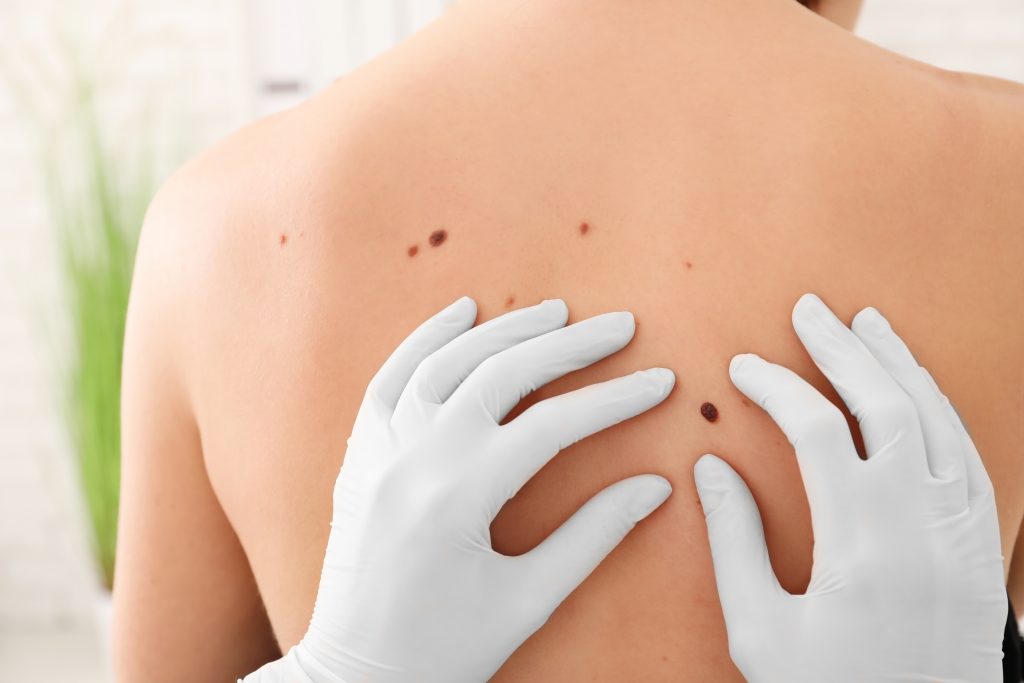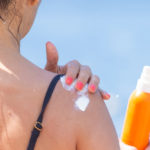May 7, 2021
What Does Skin Cancer Look Like?
Skin cancer is the most common form of cancer in the United States. Knowing what skin cancer looks like can help you determine whether you should see your doctor for diagnosis and treatment. When caught early, skin cancer can be effectively treated and stopped before it spreads to other parts of the body.
Here’s a look at the different types of skin cancers and what your next steps should be if you think you may need treatment.
What Is Skin Cancer?
Skin cancer is an abnormal growth of skin cells that usually develops in areas that have been exposed to the sun. There are many different types of skin cancer, though the most common types are basal cell carcinoma, squamous cell carcinoma, and melanoma.
Magdalena Chavez, PA-C with Healthcare Associates of Texas, located in Bedford says, “Skin cancers are the most common cancer. In fact, one in five Americans will develop skin cancer of some type before age 70. Skin cancers outnumber all other cancers combined.”
Skin cancer can affect anyone with any skin tone and can grow anywhere on the body, even in areas that aren’t typically exposed to the sun.
What Causes Skin Cancer?
Most cases of skin cancer are thought to be caused by excess exposure to ultraviolet rays from the sun, which can damage the skin and lead to DNA mutations in skin cells.
Certain factors may increase your risk of developing skin cancer. These factors include:
- Spending a lot of time in the sun
- Having fair skin that burns easily
- Having a history of sunburns, especially blistering sunburns
- Living in a sunny or high-altitude climate
- Having lots of moles or any abnormal moles
- Having precancerous skin growths that feel rough and scaly
- Having a personal or family history of skin cancer
- Having a weakened immune system
- Past exposure to radiation
- Past exposure to toxic substances, such as arsenic
What Does Skin Cancer Look Like?
Skin cancer can take on a number of different appearances and textures. Skin cancer can grow as a tiny bump, or as a scab that never seems to heal. Skin cancer can look like a mole or a brown spot, or as a lesion that bleeds and burns.
 “It’s a good idea to keep an eye on your skin. When you’re changing clothes or in the shower, just take a quick look. If you see a mole that has changed or haven’t seen before, keep an eye on it. Remember the most common place to find melanomas, especially in men, is on the back and that may be a hard place to see by yourself. It helps to check in the mirror once in a while or have someone you live with check for you. Make sure that your primary care physician is doing your physical every single year and have them check your skin while you are there,” Chavez advises.
“It’s a good idea to keep an eye on your skin. When you’re changing clothes or in the shower, just take a quick look. If you see a mole that has changed or haven’t seen before, keep an eye on it. Remember the most common place to find melanomas, especially in men, is on the back and that may be a hard place to see by yourself. It helps to check in the mirror once in a while or have someone you live with check for you. Make sure that your primary care physician is doing your physical every single year and have them check your skin while you are there,” Chavez advises.
If you see a new growth on your skin or notice that an existing mole is changing in appearance and texture, see your healthcare provider immediately for an examination.
What Are Signs of Skin Cancer?
Skin cancer symptoms will vary based on the type of skin cancer. Here are signs of skin cancer for each of the three main skin cancer types.
Basal Cell Carcinoma
Basal cell carcinoma grows in the top layer of the skin known as the epidermis and is most commonly caused by excess exposure to sunlight and ultraviolet radiation.
Signs of basal cell carcinoma include:
- Pearly or waxy bump
- Red, scaly patch of skin
- White or light pink patch of skin
- Flat or slightly raised patch of skin
- Flesh-colored or brown lesion
- A scab or bleeding sore that heals and returns, repeatedly
- A sore with a sunken middle
- Irregular blood vessels in or around the affected spot
Squamous Cell Carcinoma
Squamous cell carcinoma also grows in the epidermis and can occur in skin that is injured or inflamed, or that is undamaged.
Signs of squamous cell carcinoma include:
- Firm, red nodule
- Flat lesion that feels scaly and crusty
- Large, reddish-colored patch
- Having a sore that doesn’t heal
- Changes in an existing lesion, wart, or mole
Melanoma
Melanoma is the rarest, most dangerous form of skin cancer. Melanoma is caused by mutations in skin cells that produce color pigments known as melanocytes. This form of skin cancer often develops from moles that are present at birth, though it can also develop on normal, undamaged skin.
Signs of melanoma include:
- Mole that changes in color, size, or texture, or that bleeds
- Small lesion with an irregular border
- Lesion that has numerous colors, including white, pink, red, blue, or blue-black
- Lesion that causes pain, itching, and burning
- Large brown spot with darker speckles on the inside
- Dark lesions on the palms, soles, toes, or fingertips
- Dark lesions on mucous membranes in the nose, mouth, vagina, or anus
To detect signs of melanoma, practice the ABCDE system of melanoma:
- Asymmetry: A skin cancer mole is often asymmetrical, with one half being different from the other half.
- Borders: The edges or border of the mole or growth will be irregular.
- Color: A melanoma mole will often have a variety of colors and shades of brown and pink.
- Diameter: The diameter of a skin cancer mole is usually at least 5 millimeters.
- Evolution: A skin cancer mole usually changes in appearance frequently.
“Melanomas are the ones we worry about the most because they are the most deadly. They’re usually the ones that look the darkest in color. However, some basal cell and squamous cell skin cancers make look similar and some melanomas may look pink. There’s not a definitive way to tell what type of skin cancer you may have just by looking at it. The only way to tell for sure is to get a biopsy,” Chavez adds.
How Is Skin Cancer Diagnosed?
A doctor can diagnose skin cancer by examining the appearance and texture of the skin growth, and by performing a skin biopsy. During a biopsy, the doctor removes a tiny sample of the growth and sends it to a lab where it is screened and tested for skin cancer. A biopsy can also reveal which type of skin cancer it is. In some instances, doctors may recommend additional tests to determine the severity and progression of cancer.
What Are Treatments For Skin Cancer?
Skin cancer can be treated in one of several ways based on factors such as the cancer type and severity, and the location of the skin growth.
Freezing and surgery are some common skin cancer treatments. Freezing is ideal for small, early-stage skin cancers and destroys the affected tissue, after which it is sloughed off. Surgery involves removing the cancerous tissue and can be performed on any type of skin cancer.
Other skin cancer treatments include:
- Curettage and electrodessication, in which a doctor scrapes away the cancerous cells using a circular blade called a curette, then uses an electric needle to destroy remaining cancer cells.
- Radiation therapy, which uses high-powered energy beams to destroy cancer cells.
- Chemotherapy, which uses medications to treat cancer in the top layers of skin (topical creams or lotions) or cancer that has spread to other parts of the body (systemic).
- Photodynamic therapy, which uses medications that make cancer cells more sensitive to light, and laser light to destroy the affected cells.
- Targeted therapy, which involves the use of medications that target specific proteins in cancer cells that cause them to grow and spread.
“The most common type of skin cancer, basal cell carcinoma, can usually be treated in office, either with large section (surgery) or electrodessication. MOHS surgeries are popular for any type of cancer on the face because it gives you the least amount of scarring. More concerning cancers like melanoma, may also require some follow-up treatment such as chemo and radiation, based on spread or how large the area is.”
A doctor will recommend the best skin cancer treatment after performing an examination and biopsy of the abnormal skin growth.
How To Prevent Skin Cancer
“Reducing your risk of developing skin cancer is super important and it’s actually super easy. One way is just wearing sunscreen at least SPF 30, 30-50 in general, every single day,” says Chavez.
Skin cancer may be prevented by avoiding excess sun exposure and sunburn, and by avoiding toxic substances that can damage the skin or cause inflammation.
 Follow these steps to reduce your risk of developing skin cancer:
Follow these steps to reduce your risk of developing skin cancer:
- Avoid exposing your bare skin to the sun for long periods, especially between the hours of 10 a.m. and 4 p.m. when the sun’s rays are strongest.
- Wear a wide-brimmed hat, protective clothing, and sunscreen when spending time outdoors to avoid sunburn, including on cloudy days.
“A lot of people may not know that you should wear SPF 30-50 every single day. You are exposed to UV light through windows, like in an office building or in your car. In fact, one of the most common places to find a basal cell carcinoma is on the upper temple, we believe that has something to do with light coming in through car windows,” Chavez adds.
- Avoid tanning beds, many of which emit harmful ultraviolet rays.
- Be aware of whether you are using any medications or medicines that make your skin more sensitive to the sun. Read all drug labels and ask your doctor to confirm whether you are using medicines that may increase your risk of developing skin cancer.
- Inspect your skin regularly to detect abnormalities. Look for changes in moles, and report any new growths or changes to your doctor right away.
Our team of board-certified doctors and medical professionals at Healthcare Associates of Texas can diagnose and treat skin cancer, and help you reduce your risk. Call us today to make an appointment or request an appointment on our website.
DISCLAIMER
The information featured in this site is general in nature. The site provides health information designed to complement your personal health management. It does not provide medical advice or health services and is not meant to replace professional advice or imply coverage of specific clinical services or products. The inclusion of links to other web sites does not imply any endorsement of the material on such websites.
Ready to become your healthiest self?
Get tips delivered to your e-mail inbox every month. Let’s get happier and healthier together!




